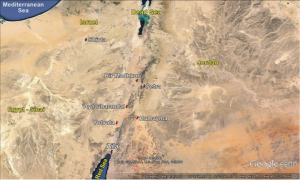
Location of Aila. (Map ©Google Earth)
BASOR No. 376, November article, “A Diachronic Look at the Agricultural Economy at the Red Sea Port of Aila: An Archaeobotanical Case for Hinterland Production in Arid Environments,” by Jennifer H. Ramsay (State University of New York) and S. Thomas Parker (North Carolina State University).
Archaeological investigations carried out by the Roman Aqaba Project seek to reconstruct the economy of the ancient seaport of Aila and contribute new evidence concerning the nature of the imperial Roman economy in the East. This study presents a component of the project that is focused on the analysis of plant remains retrieved from soil samples taken during excavations at Aila. The archaeobotanical material examined comes from the Nabataean through Abbasid periods (first through tenth centuries C.E.) and presents a diachronic perspective on the agricultural economy of the site. The feasibility of cereal agricultural production in the hyper-arid hinterland of Aila is also examined, as well as the population’s reliance on imported subsistence commodities. The results show that Aila may not have been as dependent on imported staple crops as previously assumed, which relates directly to questions regarding the size of Aila’s hinterland and its production potential. Although no physical evidence exists for the use of runoff agriculture, it is feasible it was practiced near Aila, as there is proof for it at other hyper-arid sites in the region. Likewise, it seems probable that “oasis agriculture” was practiced at Aila, and perhaps even cotton cultivation.
